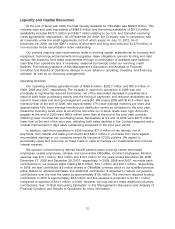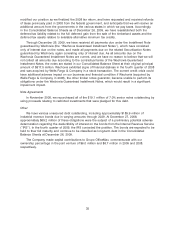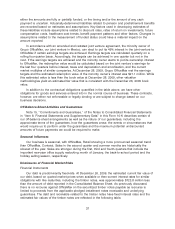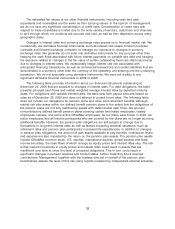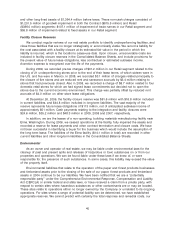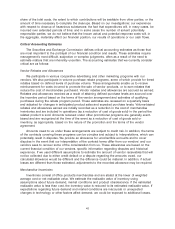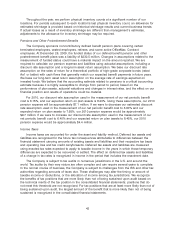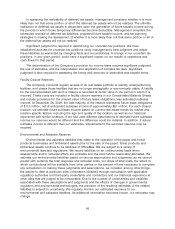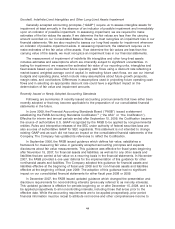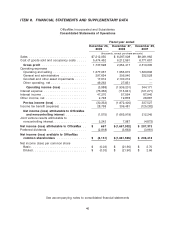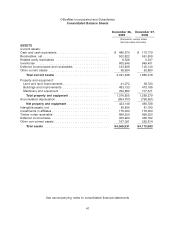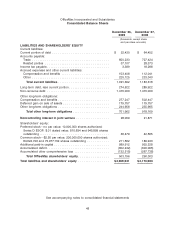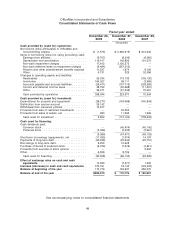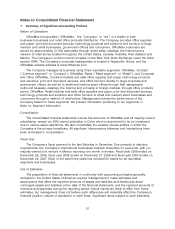OfficeMax 2009 Annual Report Download - page 45
Download and view the complete annual report
Please find page 45 of the 2009 OfficeMax annual report below. You can navigate through the pages in the report by either clicking on the pages listed below, or by using the keyword search tool below to find specific information within the annual report.share of the total costs, the extent to which contributions will be available from other parties, or the
amount of time necessary to complete the cleanups. Based on our investigations; our experience
with respect to cleanup of hazardous substances; the fact that expenditures will, in many cases, be
incurred over extended periods of time; and in some cases the number of solvent potentially
responsible parties, we do not believe that the known actual and potential response costs will, in
the aggregate, materially affect our financial position, our results of operations or our cash flows.
Critical Accounting Estimates
The Securities and Exchange Commission defines critical accounting estimates as those that
are most important to the portrayal of our financial condition and results. These estimates require
management’s most difficult, subjective or complex judgments, often as a result of the need to
estimate matters that are inherently uncertain. The accounting estimates that we currently consider
critical are as follows:
Vendor Rebates and Allowances
We participate in various cooperative advertising and other marketing programs with our
vendors. We also participate in volume purchase rebate programs, some of which provide for tiered
rebates based on defined levels of purchase volume. These arrangements enable us to receive
reimbursement for costs incurred to promote the sale of vendor products, or to earn rebates that
reduce the cost of merchandise purchased. Vendor rebates and allowances are accrued as earned.
Rebates and allowances received as a result of attaining defined purchase levels are accrued over
the incentive period based on the terms of the vendor arrangement and estimates of qualifying
purchases during the rebate program period. These estimates are reviewed on a quarterly basis
and adjusted for changes in anticipated product sales and expected purchase levels. Volume-based
rebates and allowances earned are initially recorded as a reduction in the cost of merchandise
inventories and are included in operations (as a reduction of cost of goods sold) in the period the
related product is sold. Amounts received under other promotional programs are generally event-
based and are recognized at the time of the event as a reduction of cost of goods sold or
inventory, as appropriate, based on the nature of the promotion and the terms of the vendor
agreement.
Amounts owed to us under these arrangements are subject to credit risk. In addition, the terms
of the contracts covering these programs can be complex and subject to interpretations, which can
potentially result in disputes. We provide an allowance for uncollectible accounts and to cover
disputes in the event that our interpretation of the contract terms differ from our vendors’ and our
vendors seek to recover some of the consideration from us. These allowances are based on the
current financial condition of our vendors, specific information regarding disputes and historical
experience. If we used different assumptions to estimate the amount of vendor receivables that will
not be collected due to either credit default or a dispute regarding the amounts owed, our
calculated allowance would be different and the difference could be material. In addition, if actual
losses are different than those estimated, adjustments to the recorded allowance may be required.
Merchandise Inventories
Inventories consist of office products merchandise and are stated at the lower of weighted
average cost or net realizable value. We estimate the realizable value of inventory using
assumptions about future demand, market conditions and product obsolescence. If the estimated
realizable value is less than cost, the inventory value is reduced to its estimated realizable value. If
expectations regarding future demand and market conditions are inaccurate or unexpected
changes in technology or other factors affect demand, we could be exposed to additional losses.
41


